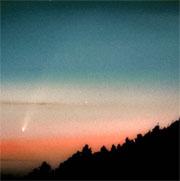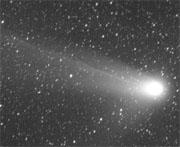 Could dark comets be orbiting unseen through our solar system?© NASA Michael Jäger and Gerald Rhemann
Could dark comets be orbiting unseen through our solar system?© NASA Michael Jäger and Gerald RhemannThe Solar System could be teeming with almost invisible comets, according to some astronomers' calculations. If they are right, such extra comets would significantly increase the risk of a catastrophic impact with Earth.
These objects have never been observed, but the astronomers argue that 'dark comets' provide a likely explanation for an astronomical puzzle: we can only see a tiny fraction of the comets that theory predicts.
Astronomers think that many comets come from the Oort cloud, a field of billions of icy objects that lies up to 100,000 times farther away from the Sun than the Earth does and marks the outer boundary of our Solar System. The icy objects are sometimes driven towards the Sun by gravitational tides generated by the shifting masses of stars in our Galaxy. When this happens they become comets, orbiting the Sun every 20 to 200 years on paths that lie at an angle to the planets' orbits.
“These things will just come out of the dark and hit you with no warning.”
Bill Napier
Armagh Observatory, Northern Ireland
Given the size of the Oort cloud, astronomers have calculated that there should be about 3,000 comets in these orbits, 400 times more than are actually observed.
The common explanation for this discrepancy is that the comets quickly disintegrate into smaller lumps after just one or two orbits, says Bill Napier, a recently retired astronomer who worked at the Armagh Observatory, Northern Ireland. But his mathematical model now suggests that, if this were true, the debris should cause many more major meteorite showers on Earth than we see, perhaps up to 30 every year.
In a paper to be published in the Monthly Notices of the Royal Astronomical Society1, Napier concludes that the predicted comets are out there after all; we just cannot see them.
Little fluffy clouds
Napier worked with Chandra Wickramasinghe, an astronomer at Cardiff University in Wales, to explain the comets' invisibility. Wickramasinghe has suggested that Sedna, the most distant body identified in our Solar System, could have an orbiting twin that is dark, fluffy and made of tarry carbon compounds (see ""Sedna 'has invisible moon'":/news/2004/040823/full/040823-3.html").
As Sedna may be a member of the Oort cloud, Napier thinks that other members of the cloud could be equally dark. Once ejected, the tarry comets would simply suck up visible light, he says, remaining cloaked in darkness. "Photons go in, but they don't come out."
"It's an intriguing possibility," says Alan Fitzsimmons, an astrophysicist at Queen's University of Belfast in Northern Ireland. "But while we have seen dark objects before, Bill is proposing something much, much darker than anything we've ever detected."
NASA's Stardust probe, which is bringing back samples of dust from the comet Wild 2, lends some support to Napier's idea. In June this year it reported finding lots of tarry carbon compounds spraying from the comet2.
Infrared challenge
The dark comets would present a major challenge to astronomers searching the skies for objects that might collide with the Earth. "They're so black you can't see the damn things," says Napier. "These things will just come out of the dark and hit you with no warning. It looks as if we're dealing with a substantial impact hazard that people haven't clicked into yet."
 Astronomers think that 'intermediate' comets - such as Halley's comet - come from the distant Oort cloud. Short period comets that orbit the Sun in less than 20 years come from the Kuiper Belt, a region just beyond Neptune's orbit.© NASA Michael Jäger and Gerald Rhemann
Astronomers think that 'intermediate' comets - such as Halley's comet - come from the distant Oort cloud. Short period comets that orbit the Sun in less than 20 years come from the Kuiper Belt, a region just beyond Neptune's orbit.© NASA Michael Jäger and Gerald RhemannHowever, although they reflect almost no visible light, the dark comets should give out a tiny glow of heat, visible as infrared radiation. The infrared Spitzer Space Telescope, which has been operating from Earth orbit for just over a year, has not seen any dark comets. But this could be because it focuses on very small, distant parts of the sky, says Napier.
Fitzsimmons disagrees, saying that if these objects existed in the numbers proposed by Napier, either Spitzer or near-Earth object surveys such as Spacewatch, based at the University of Arizona in Tucson, would have picked them up by now.
A new space telescope might provide the answer. Earlier this month, NASA announced that it would launch an orbiting infrared telescope called the Wide-field Infrared Survey Explorer (WISE) in 2008, which will map much wider areas of the sky. Given enough time, it should be able to detect the dark comets, says Napier.
Armagh Observatory, Northern Ireland
